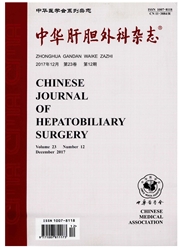

 中文摘要:
中文摘要:
目的人白细胞介素-10(interleukin 10,IL-10)是肝纤维化、肝硬化过程中的重要负性调节因子,通过AAV病毒基因转导方式,探讨hIL-10对慢性肝损伤的预防和治疗作用。方法以重组腺相关病毒(recombinant adeno-associated virus,rAAV)转移质粒载体pTR-UF5为基础构建表达质粒pTR-UF5/hIL-10。采用本室构建的高效重组AAV包装系统,产生感染性重组AAV-hIL-10,滴度4.22×10^8/ml。以硫代乙酰胺(thioacetamide,TAA)复制大鼠慢性肝损伤模型。采用肌肉注射方式将rAAV-hIL10以等量分别注射于大鼠双侧后肢内侧肌肉中,观察预防性给药(总量为150ul/100g体重)和治疗性给药(总量为200ul/100g体重)前后对大鼠血清AST、ALT、ADH和透明质酸(hyaluronic acid,HA)、层连蛋白(laminin,LN)、Ⅲ型前胶原(procollagen Ⅲ,PCⅢ)的影响。结果成功构建重组AAV-hIL10系统。重组病毒感染后,预防性和治疗性给药后较给药前,大鼠血清AST、AL,T、ADH和HA、LN、PCⅢ水平均有显著下降(P〈0.05,或P〈0.01)。16周肝脏病理学分级和大鼠生存率均有显著差异。结论重组AAV-hIL10对TAA所致慢性肝损伤具有显著的预防和治疗作用。
 英文摘要:
英文摘要:
Objective Human interleukin 10 (IL-10) is an important negative regulatory factor in the process of liver fibrosis and cirrhosis. We intend to explore the preventive and therapeutic effect of hIL-10 on chronic liver injury via the method of recombinant AAV gene transduction. Methods The expression vector pTR-UF5/hIL-10 was constructed at the basis of recombinant adeno-associated virus transferred plasmid pTR-UF5. The infectious rAAV-hIL10 was obtained via the highly effective rAAV assembly system with a titer of 4. 22× 10^8/ml. Thioacetamide (TAA) was used to replicate the chronic liver injury model in rat. rAAV-hIL10 was intramuscularly injected into the bilateral muscles of posterior limbs with one side of half of the total amount of 150 ul/100g body weight for preventive administration and 200 ul/100g body weight for therapeutic administration. The effect on serum AST, ALT, ADH and hyaluronic acid (HA), laminin (LN), procollagen Ⅲ (PCⅢ) levels was observed before and after the preventive and therapeutic administration. Results The rAAV-hIL 10 system was successfully constructed. The rat serum AST, ALT, ADH and HA, LN, PCⅢ levels decreased significantly (P〈0. 05, or P〈0. 01) after administration of rAAV-hIL10, as compared before it. Liver pathological grading and survival rate in rats by the end of 16w also had significant differences, respectively. Conclusions The rAAV-hIL10 has significant preventive and therapeutic effect on TAA-induced chronic liver injury.
 同期刊论文项目
同期刊论文项目
 同项目期刊论文
同项目期刊论文
 期刊信息
期刊信息
